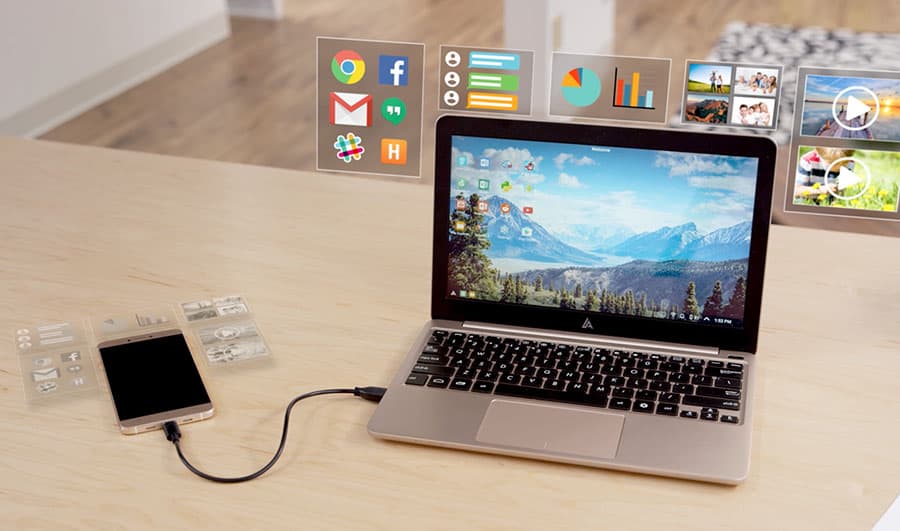
Above: Andromium’s Superbook inflates the computer in your smartphone to laptop size. Photo courtesy Andromium.
BitDepth#1074 for January 03, 2017
Wasn’t 2016 the year of the smartphone already?
It was certainly a year of cement quality consolidation for smartphones, as the upscale devices became the standard for pocketable communication for anyone who wanted to do more than make calls and could afford the upgrade from a featurephone.
But 2017 is going to be a particularly interesting year in the development of these devices, particularly in a global environment that’s increasingly committed to Voice over IP (VoIP) protocols which make the era of isolated cabled communications increasingly passé.
That’s just one vector that’s targeting the phone in our pocket for change. Increased commitment to specific and deep use smartphones, which in terms of RAM, storage capacity and processor speed already match the laptops we were using just a few years ago, is only going to increase the pace and sophistication of development.
One inventive product that proved worthy of my hard earned cash was Andromium’s rather heroically titled Superbook, a successful Kickstarter project that answered the question, “Why am I walking around with three boxes of circuitry every day?”
That might be the question asked by someone with a smartphone in their pocket, a tablet in their hand and a laptop in a bag slung over their shoulder.
Andromium rather cleverly figured out that people don’t need a full keyboard and screen all the time and would always want a source of additional power.
The startup basically gutted a 11-inch MacBook Air class laptop of its logic board, filled the space with battery cells and the necessary port connection bits to create a device that gives you a laptop form factor after you connect any recent Android phone.
The idea proved resonant enough that the company, which asked for US$50,000 to launch the project, got just shy of $3 million from customers who wanted that multi-device question answered with this upscale smartphone accessory.
All that horsepower and a sharply increasing interest in smartphone photography has also led to a steady race between device manufacturers to create the ultimate pocketable camera, with Huawei, Apple and Samsung emerging as popular contenders in a race that only benefits consumers.
Expect more development in smartphone photography, particularly in computational technology, which makes more use of the powerful processors in these devices to execute high level optical voodoo.
In the Android space specifically, there is still enormous room for improvement and growth in the software ecosystem. Google’s Play store may offer a volume of apps comparable to the numbers available on the iTunes store for iPhone users, but sloppy curation and general frontier madness make the go-to Android software store a place that demands careful consideration before hitting that “Install” button.
While there’s a lot of attention at the top end of the game, there is also a strong shift happening in mid-range and low-end devices that look set to spell the long overdue end of the feature phone.
Third world markets, particularly India, are driving the development of strongly specified smartphones, many of them SIM free (no contract), positioned at close to the entry level of the market just to appeal to where the meat of the market lies in those regions.
There is likely to be strong feature drift from the top of the line to the lower end of the smartphone market, while at the high end, expect only incremental changes. The big shifts in the space will come when experimental technologies still in development move into the mainstream.
Augmented reality has been with us for a while, most notably recently with Pokémon, but practical applications for the technology will demand greater infrastructural commitment to creating platforms that make the technology truly useful.
Foldable screens are likely to be the next big development, with several manufacturers showing prototypes meant to be worn on the wrist and unfolded or unscrolled for use.
Such bold reimaginings of smartphone technology will bring their own paradigm shifts. For the next year, we are only likely to see refinements, general tidying and incremental upgrades as smartphone manufacturers seek to recoup research costs with eye-catching designs and clever improvements on existing features.
While that happens, the steady migration of creation and media consumption will continue to smartphones as users seek to do more with the device that’s with them all day long.


